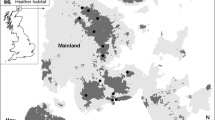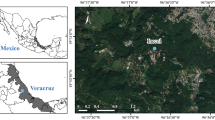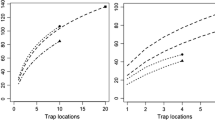Abstract
Habitat conservation for threatened temperate insect species is often guided by one of two paradigms: a metapopulation approach focusing on patch area, isolation and number; or a habitat approach focusing on maintaining high quality habitat for the focal species. Recent research has identified the additive and interacting importance of both approaches for maintaining populations of threatened butterflies. For specialised host-parasitoid interactions, understanding the consequences of habitat characteristics for the interacting species is important, because (1) specialised parasitoids are particularly vulnerable to the consequences of fragmentation, and (2) altered interaction frequencies resulting from changes to habitat management or the spatial configuration of habitat are likely to have consequences for host dynamics. The spatial ecology of Cotesia bignellii, a specialist parasitoid of the threatened butterfly Euphydryas aurinia, was investigated at two spatial scales: within habitat patches (at the scale of individual aggregations of larvae, or ‘webs’) and among habitat patches (the scale of local populations). Parasitism rates were investigated in relation to larval web size, vegetation sward height and host density. Within patches, the probability of a larval webs being parasitized increased significantly with increasing number of larvae in the web, and parasitism rates increased significantly with increasing web isolation. The proportion of webs parasitized was significantly and negatively correlated with cluster density. Among habitat patches the proportion of parasitized webs decreased as cluster density increased. Clusters with a high proportion of larval webs parasitized tended to have lower parasitism rates per larval web. These results support the call for relatively large and continuous habitat patches to maintain stable parasitoid and host populations. Conservation efforts directed towards maintenance of high host plant density could allow E. aurinia to reduce parasitism risk, while providing C. bignellii with sufficient larval webs to allow population persistence.







Similar content being viewed by others
References
Anthes N, Fartmann T, Hermann G, Kaule G (2003) Combining larval habitat quality and metapopulation structure—the key for successful management of pre-alpine Euphydryas aurinia colonies. J Insect Conserv 7:175–185
Anton C, Zeisset I, Musche M, Durka W, Boomsma JJ, Settele J (2007) Population structure of a large blue butterfly and its specialist parasitoid in a fragmented landscape. Mol Ecol 16:3828–3838
Asher J, Warren M, Fox R, Harding P, Jeffcoate G, Jeffcoate S (2001) Millennium atlas of butterflies of Britain and Ireland. Oxford University Press, Oxford
Betzholtz P-E, Ehrig A, Lindeborg M, Dinnetz P (2007) Food plant density, patch isolation and vegetation height determine occurence in a Swedish metapopulation of the marsh fritillary Euphydryas aurinia (Rottemburg, 1775) (Lepidoptera, Nymphalidae). J Insect Conserv 11:343–350
Boardman P (2003) Assessment of condition status for the marsh fritillary Eurodryas aurinia on the Gower commons/Tiroedd Comin Gwyr, Candidate special area of conservation. (ed. by Cyngor-Cefn-Gwlad-Cymru and Country-Side-Council-of-Wales). CCW Contract Science
Bulman CR, Wilson RJ, Holt AR, Bravo LG, Early RJ, Warren MS, Thomas CD (2007) Minimum viable metapopulation size, extinction debt and the conservation of a declining species. Ecol Appl 17:1460–1473
Calabrese JM, Fagan WF (2004) A comparison-shopper’s guide to connectivity metrics. Front Ecol Evol 2:529–536
CEC (1992) The conservation of natural habitats and wild fauna and flora (Council Directive 92/43/EEC) (ed. by CEC), Brussels
Crawley MJ (2007) The R book. Wiley, Chicester, UK
Cronin JT (2004) Host-parasitoid extinction and colonization in a fragmented prairie landscape. Oecologia 139:503–514
Dennis RLH, Shreeve TG, Van Dyck H (2006) Habitats and resources: the need for a resource-based definition to conserve butterflies. Biodivers Conserv 15:1943–1966
Doak P (2000) The effects of plant dispersion and prey density on parasitism rates in a naturally patchy habitat. Oecologia 122:556–567
Dobson AP, Bradshaw AD, Baker AJM (1997) Hopes for the future: restoration ecology and conservation biology. Science 277:515–522
Dubbert M, Tscharntke T, Vidal S (1998) Stem-boring insects of fragmented Calamagrostis habitats: herbivore-parasitoid community structure and the unpredictability of grass shoot abundance. Ecol Entomol 23:271–280
Early R, Anderson B, Thomas CD (2008) Using habitat distribution models to evaluate large-scale landscape priorities for spatially dynamic species. J Appl Ecol 45:228–238
Elzinga JA, Turin H, van Damme JMM, Biere A (2005) Plant population size and isolation affect herbivory of Silene latifolia by the specialist herbivore Hadena bicruris and parasitism of the herbivore by parasitoids. Oecologia 144:416–426
Elzinga JA, van Nouhuys S, van Leeuwen DJ, Biere A (2007) Distribution and colonisation ability of three parasitoids and their herbivorous host in a fragmented landscape. Basic Appl Ecol 8:75–88
Esch S, Klinkhamer PGL, van der Meijden E (2005) Do distances among host patches and host density affect the distribution of a specialist parasitoid? Oecologia 146:218–226
Ewers RM, Didham RK (2006) Confounding factors in the detection of species responses to habitat fragmentation. Biol Rev 81:117–142
Fowles AP, Smith RG (2006) Mapping the habitat quality of patch networks for the marsh fritillary Euphydryas aurinia (Rottemburg, 1775) (Lepidoptera, Nymphalidae) in Wales. J Insect Conserv 10:161–177
Hanski I (1999) Metapopulation. Ecology Oxford University Press, Oxford
Hanski I, Thomas CD (1994) Metapopulation dynamics and conservation: a spatially explicit model applied to butterflies. Biol Conserv 68:167–180
Hassell MP, Southwood TRE (1978) Foraging strategies of insects. Annu Rev Ecol Syst 9:75–98
Heisswolf A, Reichmann S, Poethke HJ, Schroder B, Obermaier E (2008) Habitat quality matters for the distribution of an endangered leaf beetle and its egg parasitoid in a fragmented landscape. J Insect Conserv 13:165–175
Hilszczanski J, Gibb H, Hjaltén J, Atlegrim O, Johansson T, Pettersson RB, Ball JP, Danell K (2005) Parasitoids (Hymenoptera, Ichneumonoidea) of Saproxylic beetles are affected by forest successional stage and dead wood characteristics in boreal spruce forest. Biol Conserv 126:456–464
Jones TH, Godfray HCJ, Hassell MP (1996) Relative movement patterns of a tephritid fly and its parasitic wasps. Oecologia 106:317–324
Juillet JA (1964) Influence of weather on flight activity of parasitic Hymenoptera. Can J Zool 42:1133–1141
Klapwijk MJ, Lewis OT (2006) The effect of climate on host-parasitoid synchrony: marsh fritillary populations in Wales, rep. no. FC 73-01-515, Countryside Council for Wales, Bangor
Klapwijk MJ, Grobler BC, Ward K, Wheeler D, Lewis OT (2010) Influence of experimental warming and shading on host-parasitoid synchrony. Glob Change Biol 16:102–112
Komonen A, Penttila R, Lindgren M, Hanski I (2000) Forest fragmentation truncates a food chain based on an old-growth forest bracket fungus. Oikos 90:119–126
Konvicka M, Hula V, Fric Z (2003) Habitat of pre-hibernating larvae of the endangered butterfly Euphydryas aurinia (Lepidoptera: Nymphalidae): What can be learned from vegetation composition and architecture? Eur J Entomol 100:313–322
Kruess A, Tscharnkte T (2000) Species richness and parasitism in a fragmented landscape: experiment and field studies with insects on Vicia sepium. Oecologia 122:129–137
Lei GC, Hanski I (1997) Metapopulation structure of Cotesia melitaearum, a specialist parasitoid of the butterfly Melitaea cinxia. Oikos 78:91–100
Lewis OT, Hurford C (1997) Assessing the status of the marsh fritillary butterfly (Eurodryas aurinia): an example from Glanmorgan, UK. J Insect Conserv 1:159–166
Liu W, Wang Y, Xu R (2006) Habitat utilization by ovipositing females and larvae of the Marsh fritillary (Euphydryas aurinia) in a mosaic of meadows and croplands. J Insect Conserv 10:351–360
Monmany AC, Aide TM (2009) Landscape and community drivers of herbivore parasitism in Northwest Argentina. Agric Ecosyst Environ 134:148–152
Porter K (1981) Population dynamics of small colonies of the butterfly Euphydryas aurinia. Ms. D.phil, University of Oxford, Oxford
Porter K (1983) Multivoltinism in Apanteles bignellii and the influence of weather on synchronization with its host Euphydryas aurinia. Entomol Exp Appl 34:155–162
Porter K, Ellis S (2011) Securing viable metapopulations of the marsh fritillary butterfly, Euphydryas aurinia, (Lepidoptera: Nymphalidae) in Northern England. J Insect Conserv 15:111–119
Prugh LR, Hodges KE, Sinclair AR, Brashares JS (2008) Effect of habitat area and isolation on fragmented animal populations. Proc Natl Acad Sci 105:20770–20775
R-Development-Core-Team (2010) R: A language and environment for statistical computing, Version 2.12.0. R-Foundation-for-Statistical-Computing
Revels R (1994) The rise and fall of the holly blue butterfly. B Wildl 5:236–239
Sala OE, Chapin FS, Armesto JJ, Berlow E, Bloomfield J, Dirzo R, Huber-Sanwald E, Huenneke LF, Jackson RB, Kinzig A, Leemans R, Lodge DM, Mooney HA, Oesterheld M, Poff NL, Sykes MT, Walker BH, Walker M, Wall DH (2000) Biodiversity: global biodiversity scenarios for the year 2100. Science 287:1770–1774
Samways MJ (2007) Insect conservation: a synthetic management approach. Annu Rev Entomol 52:465–487
Schroeder LM (2007) Escape in space from enemies: a comparison between stands with and without enhance densities of the spruce bark beetle. Agric For Entomol 9:85–91
Shaw MR (2006) Habitat considerations for parasitic wasps (Hymenoptera). J Insect Conserv 10:117–127
Shaw MR, Hochberg ME (2001) The neglect of parasitic hymenoptera in insect conservation strategies: the British fauna as a prime example. J Insect Conserv 5:253–263
Stewart KEJ, Bourn NAD, Thomas JA (2001) An evaluation of three quick methods commonly used to assess sward height in ecology. J Appl Ecol 38:1148–1154
Stork NE, Lyal CHC (1993) Extinction or co-extinction rates. Nature 366:307
Thies C, Steffan-Dewenter I, Tscharntke T (2003) Effects of landscape context on herbivory and parasitism at different spatial scales. Oikos 101:18
Thomas J, Lewington R (2010) The butterflies of Britain and Ireland, 2nd edn. British Wildlife Publishing Ltd., Gillingham, Dorset, UK
Thomas JA, Bourn NAD, Clarke RT, Stewart KE, Simcox DJ, Pearman GS, Curtis R, Goodger B (2001) The quality and isolation of habitat patches both determine where butterflies persist in a fragmented landscape. Proc R Soc Lond Ser B Biol Sci 268:1791–1796
Tscharnkte T, Steffan-Dewenter I, Kruess A, Thies C (2002) Contribution of small habitat fragments to conservation of insect communities of grassland–cropland landscapes. Ecol Appl 12:354–363
Turlings TJ, Tumlinson J, Heath R, Proveaux A, Doolittle R (1991) Isolation and identification of allelochemicals that attract the larval parasitoid, Cotesia marginiventris (Cresson), to the microhabitat of one of its hosts. J Chem Ecol 17:2235–2251
Turlings TCJ, Loughrin JH, McCall PJ, Rose USR, Lewis WJ, Tumlinson JH (1995) How caterpillar-damaged plants protect themselves by attracting parasitic wasps. Proc Natl Acad Sci USA 92:4169–4174
van Nouhuys S, Hanski I (2002) Colonization rates and distances of a host butterfly and two specific parasitoids in a fragmented landscape. J Anim Ecol 71:639–650
van Nouhuys S, Tay WT (2001) Causes and consequences of small population size for a specialist parasitoid wasp. Oecologia 128:126–133
Vanbergen AJ, Jones TH, Hails RS, Watt AD, Elston DA (2007) Consequences for a host-parasitoid interaction of host-plant aggregation, isolation and phenology. Ecol Entomol 32:419–427
Vet LE, Dicke M (1992) Ecology of infochemical use by natural enemies in a tritrophic context. Annu Rev Entomol 37:141–172
Waage JK (1979) Foraging for patchily distributed hosts by the parasitoid, Nemeritis canescens. J Anim Ecol 48:353–453
Wahlberg N, Klemetti T, Hanski I (2002) Dynamic populations in a dynamic landscape: the metapopulation structure of the marsh fritillary butterfly. Ecography 25:224–232
Warren MS (1994) The UK status and suspected metapopulation structure of a threatened European butterfly, the Marsh Fritillary, Eurodryas aurinia. Biol Conserv 67:239–249
Weisser WW, Volkl W, Hassell MP (1997) The importance of adverse weather conditions for behaviour and population ecology of an aphid parasitoid. J Anim Ecol 66:386–400
Acknowledgments
We thank Adrian Fowles, Mark Shaw and Richard Smith for their help and advice. We thank Emma Trainor at the Countryside Council for Wales in Swansea with help obtaining site ownership. Last, we extent our thanks to the private landowners for permitting access to their land, the national trust for allowing us to work on Welsh Moor and The Gower Commoners Association for allowing us to work on their commons. Funding for this work was provided by The Countryside Council for Wales under Contract Number FC 73-01-515. CWW also granted permission to collect E. aurinia larvae.
Author information
Authors and Affiliations
Corresponding author
Rights and permissions
About this article
Cite this article
Klapwijk, M.J., Lewis, O.T. Spatial ecology of host–parasitoid interactions: a threatened butterfly and its specialised parasitoid. J Insect Conserv 18, 437–445 (2014). https://doi.org/10.1007/s10841-014-9653-5
Received:
Accepted:
Published:
Issue Date:
DOI: https://doi.org/10.1007/s10841-014-9653-5




